By Wayne Lincourt
Meopta
https://www.meoptasportsoptics.com/us/
Thanks to modern manufacturing processes, today’s rifles have accuracies of one to two minutes of angle right out of the box. However, if you want to realize that potential, you’ll need a scope that’s in the same ballpark. The hard part, of course, is deciding which of the multitude of scopes in the marketplace is best for you. After all, they all look pretty much the same. But when you look a little closer, the differences begin to emerge. I don’t generally get too excited about scopes, but as an astronomy buff and licensed optician, when I get to use an optical instrument of this caliber, it’s hard not to get excited.
Meopta is owned by an American family of Czech descent. The European headquarters is in the Czech Republic; its US headquarters is on Long Island, NY. The Meostar line of 30mm scopes is manufactured in the Czech Republic, while the 1-inch MeoPro line is manufactured in Long Island. Although the company is not well known here, you’ve certainly heard of some of the premium scope makers for which it has built scopes and scope parts for decades. The point is, it has a lot of experience manufacturing top-of-the-line scopes.
All premium scopes use purged tubes filled with an inert gas like nitrogen or argon. The MeoStar is no exception. Its 30 mm tube is milled from a solid block of aircraft-grade aluminum alloy, filled with nitrogen to eliminate fogging. It’s also waterproof, dustproof, shock proof, etc. You expect that at this price point. What sets this scope apart from its competitors, though, is its image quality.
Although the best scope builders all use top-of-the-line glass, what none of the others have is the formula for the Meopta lens coatings. You probably know that lens coatings are what determine how much light gets through the scope, but did you know that they also affect image clarity? There’s a lot of misunderstanding when it comes to lens coatings and their importance. Some of that is intentional. It’s expensive to develop and properly apply high tech coatings. Manufacturers producing cheaper scopes want you to think their scopes are just as good as more expensive offerings. They’ll tell you that their lenses are coated too, but that may just mean that some of the lens surfaces have a single coating. The best scopes are “fully multicoated,” which means that all glass-to-air surfaces have multiple coatings.
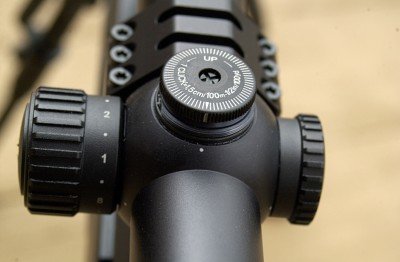
The adjustment knobs for zeroing the reticle are on the top and right hand side. No tool is necessary to adjust them. Once the scope is zeroed to your satisfaction, press the adjustment knob in and turn it so that the hash mark lines up with the dot on the scope body. Then you can make adjustments as the situation dictates and easily return to your original zero.
Coatings work by preventing light from reflecting from the lens surface. Light acts like a wave when it reflects from the boundary between glass and air, just like waves in water striking a retaining wall. As the waves reflect, they interact with one another, causing interference patterns. In a scope, the interference patterns make images appear fuzzy or not sharply focused. Therefore, the better the light transmission, the sharper the image. The MeoStar R2 1-6×24 RD has the best light transmission of any competitive rifle scope — 99.8% per glass surface. That’s an amazing number, and it means that you get the brightest, sharpest images possible. The brightness allows you to use the scope in lower light conditions, like early in the morning or at dusk when many game animals are more active. It also means that you can make out more detail, like — are those horns on that deer or branches from the tree it’s standing under?
Many scopes focus clearly in the center but are a little off at the edges. This is due to the curvature of the lenses and the fact that the manufacturer doesn’t do what it takes to eliminate the aberration. When you look through the MeoStar R2, the image is sharp and clear from one edge to the other. That takes careful attention to lens grinds, the index of refraction of the glass and the way the lenses are paired. The best way to buy a scope is to look through it in a side-by-side comparison with the other scopes you’re considering. When you look through the MeoStar, you’ll see an image that is so clear that, as Elmer Keith put it, you feel like you can “see the Promised Land.”
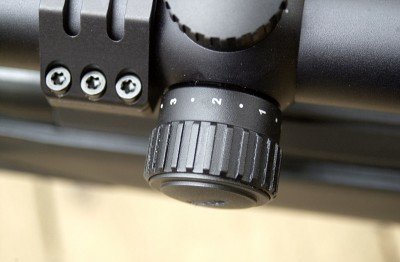
The illumination setting knob is mounted on the left hand side of the scope where it’s easily accessible. There are off positions between each level so that you don’t have to go through all the settings every time you turn it on.
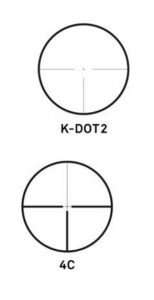
The MeoStar R2 is available with either of these reticles. Both have a sharp 1.72 MOA dot in the center.
The MeoStar R2 1 also has a number of convenience factors that are appealing. The scope reticle is etched in glass with an illuminated center red dot. With the dot turned off, you can still see and use the reticle. The illuminated dot makes target acquisition faster, though, and there are eight levels of brightness, making the dot visible even in bright sun. Since the reticle is in the second focal plane, the reticle appears the same size regardless of the magnification, which is what most American hunters prefer.
Magnification starts at a true 1 power. For close-in shots or shots at rapidly moving game, you can keep both eyes open for quicker acquisition. The red dot will be superimposed over where the shot will go. The MeoStar R2 1-6×24 RD is really designed for hunting, but the 1 power setting makes it useable for home defense, CQB or 3-gun competition.
The scope weighs just over a pound (17.4 oz.), and the absence of a large bell on the objective end means you can mount it lower on your receiver, closer to the bore axis. The red dot brightness control is mounted on the left side of the scope. There is an off position in between each brightness level so that you don’t have to go through all the levels every time you turn it on.
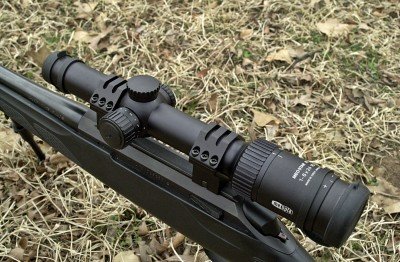
The MeoStar R2 1-6×24 RD is a high quality scope for hunting, home defense, CQB, or 3-gun competition.
The elevation and azimuth adjusting knobs don’t require a screwdriver; you just turn them with your fingers. Each click is 1/2” at 100 yards. Once you have your scope zeroed, press in the adjusting knobs to disengage the gears and rotate the adjustment wheel until the white hash-mark lines up with the white dot on the scope tube. Now when you make adjustments for a particular situation, you can easily go back to your original zero. The adjustment caps are metal, by-the-way, not plastic.
The power ring adjusts quickly from 1x to 6x. There’s even a raised bar to assist, especially handy when wearing gloves. There’s a built-in sunshade 1.447” deep, and lens caps are included.
MSRP is $1595. That’s about $500 less than comparable scopes. The street price is even lower at $1399.99. It’s still not cheap, but for an all around, lightweight, durable, high-performance scope with a lifetime transferrable warranty, the MeoStar R2 1-6×24 RD is an exceptional value. If you want to get the most from your rifle, this is a great way to go.
Meopta MeoStar
R2 1-6×24 RD
Technical Specifications
Magnification 1-6x
Dioptric Compensation 3 diopters
Objective Lens 24 mm
Main Tube Size 30 mm
Exit Pupil Diameter 11.0-4.0 mm
Eye Relief 3.9-3.8 in
Field of View 21.3-3.63°
Field of View 113-19 ft @ 100 yds
Focal Plane Position Second
Illuminated Center Dot 1.72 moa
Adjustment Per Click ½ inch @ 100 yds
Windage / Elevation Adj. Range 40-100 MOA
Parallax Correction No
Length 11.7 in
Weight 17.4 oz
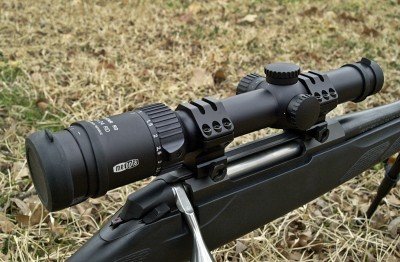
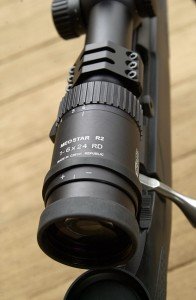
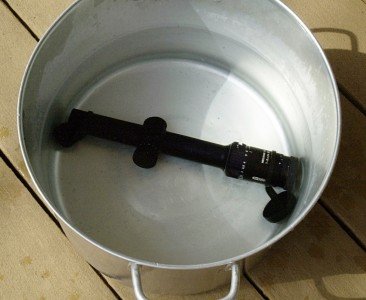
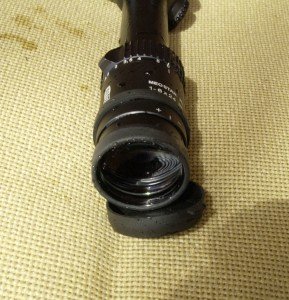
I finally bought a Meopta bino 10×42 a couple years ago ..At 66 I have looked through many brands and prices…I guarantee you can tell the difference between good glass and cheap and I finally spent a little more..I wish I had done this years ago instead of wasting money on stuff that ain’t worth a nickle in low light..I am extremely happy with my purchase..This is top of the line at a lot less money…Cabella’s Euro is Meopta re-branded..
I have a 70 year old cousin who is a victim of macular degeneration. He owns several Leupold scopes. He recently purchased a Meopta. The Meopta is the only scope he can through clearly. In optics top quality comes with a price.
If you can’t tell the difference between a Swarovski, Zeiss, or Meopta and a Leupold, Weaver, Bushnell you have special eyeballs. In optics you get what you pay for period. While hunting coyotes one foggy morning I spotted a coyote sitting next to a dead bull approximately 200 yards away through my Swarovski binoculars. I lined up on it with my 22-250, but I could not see it through my Whitetail scope. That was over ten years ago. That scenario has been repeated since. I now have a Swarovski scope on my rifle as well. At 67 years of age I can afford better equipment than at age 20. At age 20 I had a 7.5X scope on my varmint rifle. By age 60, 15X is better. The light gathering quality of the higher priced scopes is superoir.
Burn!!!
I’ve read several positive reviews on Meoptra scopes. Like some others here, I have settled on Leupold for my hunting rifles, but would not be opposed to the Meoptra- I favor that power range for a rifle of .308/.30-06 trajectory, but have no particular use for 30 mm scopes and illuminated reticles, due weight and bulk issues. 1/2″ per click seems a little coarse as well… Too, as a civilian, I am not in need of a “weapons system” for a hunting rifle so I’m certain, I would not be of primary market focus as a buyer of this kind of glass.
I would want to find one of their scopes in a one inch, sub-14 oz, 1/4″ click, in 1×6, 2×7, or 3×9, and with sufficient eye relief, (3.75″+)- and happily compare it against my Leupolds, and Nikons.
I have Meoptas on all of my hunting guns and have had great performance from them for over 10 years. Your statement “Meopta, an American family-owned, multinational company with headquarters in the US, has been building scopes since 1933.” was a little surprising since I was pretty sure Meopta was a Czech Republic company. I knew they had a distributor in the US but I checked the company is still in the CZ Republic.
It is a Czech republic manufacturer but the US importer is its own stand alone company. Meopta has been making OEM scopes for others and only a few years ago developed this dedicated US importer under the Meopta name. Meopta was available here in small numbers, but you wouldn’t see it in Cabelas, which you will now.
Actually Meopta made a line of scopes just for Cabelas maybe three years back. I have followed Meopta pretty closely for over 10 years as they offer great bang for the buck. Probably the best low light transmission available unless you pay 2x for, the transmission is not just due to the proprietary coating but also due to the surface quality of the polish on the lens.
I still see no way you can state “Meopta, an American family-owned, multinational company with headquarters in the US, has been building scopes since 1933.” People the headquarters are in the Czech Republic the US-owned distributor does not build the scopes or any of the other optics produced by Meopta as stated by the author of this piece. The author should have done better research on Meopta before writing the piece and commenting on Cabelas offering Meopta scopes. I understand you are an optician so you sell stuff designed and built by optical engineers like myself.
Unlike Zeiss or Swarowski which are European owned companies with US distribution , Meopta is US owned and we bought the Czech Company twent years ago.
The owners live in NY and we have manufactured over 300,000 Riflescopes in our Long Island factory.
The Czech Guys are amazing engineers and craftsman and most everything we build originates there but the writer is right about our American ownership
Matt,
I can’t speak for this scope as I haven’t used it specifically but scopes like this are not designed for the guys who can’t tell the difference between a couple hundred dollar scope and a several thousand dollar one. You may fall into that category but a lot of people expect more out of their weapon system than that. Most cheap scopes simply don’t hold up to the abuse that competition or carrying a rifle for defense of life actually puts one through.
Not to mention a lot of what you are paying for is the true 1x feature, daylight visible illumination, and glass quality. If you don’t know why those features are key and worth more money then I agree this scope is probably more expensive than your use of it justifies.
Personally I use a vortex razor 1-6 and love it but know some high level competitors that are very happy with the meopta options.
I’ve been taking to a lot of other guys out there and scopes like these (while they are cool and have all the neat bells and whistles) are just not worth the coin. For the same amount of money, someone could buy another quality rifle and 3 or 4 other scopes plus ammo! Most shooters can’t tell the difference between a scope that costs $300-$400 and one that costs $3,000 or more. So that tells me people are reverting to the same bad habits that have infected fashion – they use their disposable income to buy expensive scopes to be exclusive (the shooter’s equivalent to buying expensive clothes to hang out with the “cool” clique). Companies like Weaver, Burris and Bushnell have come light-years in manufacturing quality glass for their more affordable lines. 6x magnification is the same whether you are looking through a Trijicon ACOG or a 2-7x Weaver classic. Another thing to think about – in the Military, I watched plenty of good scopes get broken for all kinds of stupid reasons. Say you spend an arm and a leg to buy the newest fad and it gets broken (in fire-fights, scopes can get damaged every easily) – you’re going to out that scope with no replacement. That’s something you will probably have come to depend upon and now your actually worse off than if you had never bought it to begin with. My advice: stay away from the real expensive scopes and keep your options in the $200 – $500 range. A good old fashion Leupold 3×9 power scope (which falls into that range) is one of the best options that shooters can choose to invest in but don’t get limited by brand name.
Great advice Mat, I opted for the Leatherwood CMR and am very happy. I am one of those people who always “made do with what they had ” when I was younger. now that I am older and have more income I want the “best of the best” and can get caught up in the rave reviews, but sometimes it’s better to have the best of the affordable. Thanks for your wise perspective.
We have a few of the Hi-Lux/Leatherwood scopes and they are great for the money, but they aren’t like these Meopta scopes. Where you see the big difference is in reduced light.
hey Matt i thing it depends what you want and what you can afford but please don”t tell anybody that quality and glass in Meopta R2 is the same as is in Trijicon or Weaver. please for future do yourself a favor do more research.